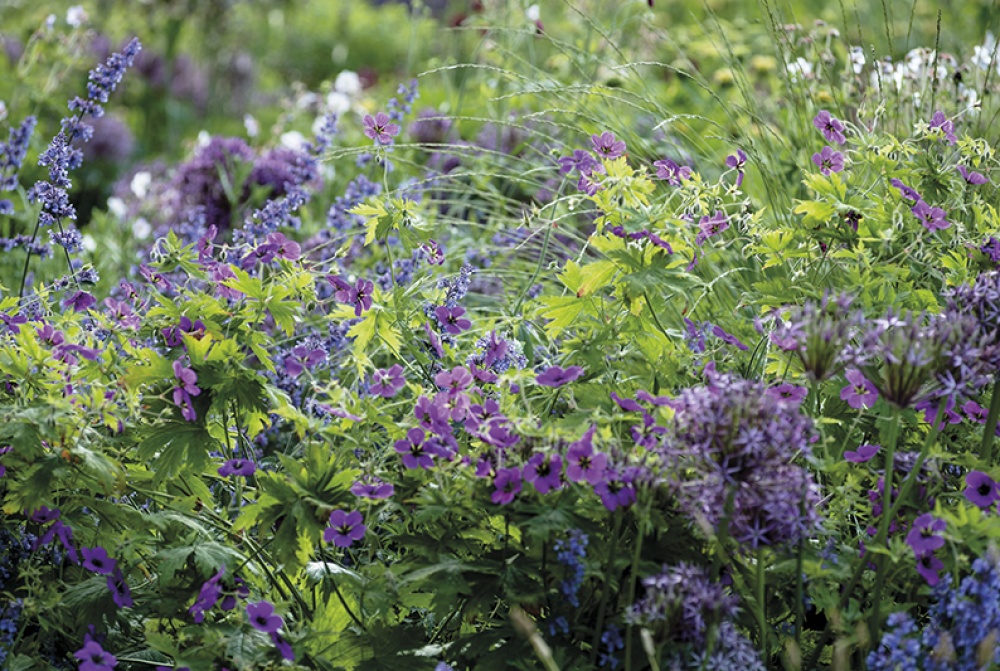How to Choose Which Plants to Grow in Your Garden

Which wild plants can you use to add drama to your garden?
Choosing which plants to grow in your new garden is all about creating clever combinations. Combine different shapes, and use plants that help each other out.
The most important question to ask yourself when you start to write the plant list for your garden is ‘What do I really want to grow?’ Think about the plants that you like best and pinpoint exactly why you like them. Is it their wonderful colour? Or the way they move about in the wind? Maybe you know they are a favourite with bees. Choose one plant that you particularly love and use it as the starting point and build your plant list around it.
Not every plant on your list needs to be a showstopper – it’s important to include some quieter elements. Background plants create a matrix that lets the bold ones shine out.
Smaller plants and grasses are good as background or matrix plants. They are brilliant for bringing a change of rhythm and a different height to your planting scheme between the showier flowers.
KEEPING IT SIMPLE
The best way to achieve a cohesive design is to limit the number of different plants you have in your garden, with the same shapes and colours repeating again and again. Think about a wild space, where the same flowers appear and reappear in different spots. Including many different flowers can look too busy, especially in a smaller garden, as everything competes for attention. As a guideline, restrict yourself to seven different plants in three different shapes. Repetition is key.
Early summer
Friends with benefits
Knautia macedonica • Phlomis russeliana
Phlomis russeliana pairs well with Knautia macedonica. Whorled up and down poker-straight stems, the phlomis flowers echo knautia’s dots atop their whippy stalks. Both flowers are as round as buttons, brightly coloured and a similar size. The strong stalks of the phlomis help knautia reach for the skies. This is a tall combination that you can see through and enjoy the plants behind
Early summer
Cheek by jowl
Allium cristophii • Geranium × oxonianum ‘Rose Clair’
• Nepeta racemosa ‘Walker’s Low’
• Sesleria autumnalis
Nepeta, geraniums and sesleria grass knit happily together here with a ribbon of alliums running through. Nepeta racemosa ‘Walkers Low’ and Allium cristophii work well in the same scheme. Although the flowerheads are different shapes – one is a spike and the other is round – both are made up of numerous small flowers. There’s space here too for Geranium × oxonianum ‘Rose Clair’ to show off the neat geometry of its flowers. This combination will swiftly fill its space but because the plants all branch from central points rather than racing off, it won’t spread too much for a small garden
Midsummer
Kaleidoscope of shapes
Echinacea pallida • Eryngium agavifolium • Salvia nemorosa ‘Caradonna’
Different flower shapes are used here to make a garden that happily straddles the seasons. Salvia nemorosa ‘Caradonna’ spikes, Echinacea pallida dots and Eryngium agavifolium umbels grow well together and even after the colours fade their architectural seedheads will echo the shapes of their flowers. As well as the visual attraction they provide, flowers of different shapes attract a range of pollinators, too, as some insects are adapted to be able to access the centre of particular plant form
Early autumn
Shape first
Allium atropurpureum (seedhead) • Molinia caerulea subsp. caerulea ‘Moorhexe’ • Perovskia atriplicifolia ‘Blue Spire’ • Sedum telephium ‘Matrona’
Providing a trinity of flathead, spike and grass, this sedum, perovskia and sesleria scheme has contrast as the key. The flat horizontals of Sedum ‘Matrona’ juxtapose perovskia’s upward spires and the grass adds an extra vertical. Allium atropurpureum will have finished flowering and now its beaded seedheads will pick up the shape and texture of the sedum.
Early autumn
Height is everything
Pennisetum orientale ‘Tall Tails’
• Verbena macdougalii ‘Lavender Spires’
Pennisetum’s caterpillar spikes are a good match for Verbena macdougalii ‘Lavender Spires’. Both plants have skinny stalks and long, narrow shapes. They flower at the same time and at the same height, and with scant leaves to interrupt the flowers they weave together easily.
Early autumn
Points of colour
Anemone × hybrida ‘Hadspen Abundance’ • Panicum virginatum ‘Shenandoah’
• Sanguisorba officinalis ‘Red buttons’
Rosy Anemone hupehensis ‘Hadspen Abundance’ is the star of this dot and panicle scheme. It flowers from midsummer to mid-autumn. The round, velvety flowers are set off by sanguisorba’s pinpricks of colour. Airy Panicum virgatum ‘Shenandoah’ adds a lighter note that ripples in the breeze.
Early autumn
Bold blocks
Agastache (seedheads) • Eryngium yuccifolium • Eurybia × herveyi • Seslaria autumnalis
Clean lines and simple shapes make this layered combination. Blocks of Eryngium yuccifolium, Sesleria autumnalis and Eurybia × herveyi grow to different heights. The agastache that flowered in summer adds another layer and picks up the shapes of the other plants.
Early autumn
Repeat, repeat
Allium atropurpureum • Eryngium yuccifolium • Helenium ‘Moerheim Beauty’
Mixing flowers with similar shapes but different weights creates rhythm. Allium atropurpureum, Eryngium yuccifolium and Helenium ‘Moerheim Beauty’ take up different amounts of space; the helenium flowers grow closely together, eryngiums are branched and the alliums are widely apart, one flower per stalk



